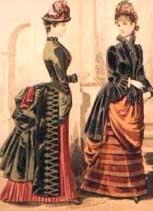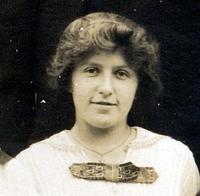
I have to wonder sometimes why I have such a fascination or passion for the fashions of the Victorian Era when I am clearly a feminist (the ultimate feminist according to my son-in-law).
My inner self seems to be fighting with itself. Women's rights versus love of a time when women had, basically, no rights, but, wore the most beautiful dresses.
So, I thought that maybe I should investigate this further. What is it that draws me to the era when it is so contrary to my basic beliefs.
According to the American Heritage Dictionary feminism is "a doctrine that advocates or demands for women the same rights granted to men, as in political or economic status."
Feminists clearly believe in this, so therefore I clearly am a feminist (and
PROUD of it to boot). In fact, make that
VERY PROUD.
According to the American Heritage Dictionary a Victorian is defined as "Pertaining or belonging to the period of Queen Victoria's reign. Exhibiting qualities usually associated with the time of Queen Victoria, as moral severity or
hypocrisy, middle-class stuffiness, and pompous conservationism. A person belonging to or exhibiting characteristics typical of the period of Queen Victoria."
Clearly, I am not Victorian.
Clearly, their
attitudes towards women and society is for the BIRDS (maybe they don't even want to be associated with it).
Yet, I am drawn to their fashions. Drawn to their style. Why?
Why do I love to make
Victorian dolls when I clearly am not Victorian? I am as perplexed as you are.
Perhaps, I should explore this further and delve a little more into the rights of women during the Victorian Era.
Maybe if I get so disgusted with their lack of rights I'll stop loving the Victorian Era and Victorian Fashion.
Maybe, I'll stop designing
Victorian dolls? Maybe, I'll stop designing dolls all together. Maybe, I'll stop loving dolls. Maybe, I'll stop loving history and genealogy.
Maybe, I'll turn into a Victorian and start to believe their treatment of women was right. Yeah! Right!
In your dreams Queen Victoria!

When I think of a "Lady" either I picture someone like Audrey Hepburns' character in "My Fair Lady" or I picture a Victorian woman like the picture to the left. Someone refined and dignified. Someone who has good manners and who also just happens to be wearing a beautiful Victorian dress. I always seem to get back to the Victorian dresses, don't I? Must be an obsession. Yah think? In my mind, a "Lady" is the ultimate perfect female. But, is she really?
So, let's take a good look at what constitutes a "Lady." According to the American Heritage Dictionary a "Lady" is a woman having the refined habits, gentle manners, and sense of responsibility often associated with breeding, culture, and high station; the feminine equivalent of a gentleman.







 I love to just browse thru history books, genealogy records, and the encyclopedia. Browsing thru the Wikipedia encyclopedia I came across the women's suffrage stamp (see picture on the left). In looking at the women's suffrage stamp I got to thinking about my great, great Aunt "Flossie" and my Grandmother "Dee." Why did these two women come to mind when I saw the stamp? They came to mind because they grew up during the time that the women's suffrage movement was at its peak.
I love to just browse thru history books, genealogy records, and the encyclopedia. Browsing thru the Wikipedia encyclopedia I came across the women's suffrage stamp (see picture on the left). In looking at the women's suffrage stamp I got to thinking about my great, great Aunt "Flossie" and my Grandmother "Dee." Why did these two women come to mind when I saw the stamp? They came to mind because they grew up during the time that the women's suffrage movement was at its peak. My "Flossie" Victorian doll is named after my great, great Aunt Florence (who is shown on the left). My great, great Aunt Flossie was born in 1882 and was the first women to go to college in our family. She graduated from Tufts University in 1904. She then went on to be one of the first women to work for the State Department of Corporations and Taxation. She worked for the state until she retired in 1947.
My "Flossie" Victorian doll is named after my great, great Aunt Florence (who is shown on the left). My great, great Aunt Flossie was born in 1882 and was the first women to go to college in our family. She graduated from Tufts University in 1904. She then went on to be one of the first women to work for the State Department of Corporations and Taxation. She worked for the state until she retired in 1947. My great, great Aunt "Flossie" was a true believer of women's rights, as was my Grandmother "Dee". Both women were very intelligent and were very strong women. Both were very confident in themselves and both held strong beliefs and convictions. They both were believers in women's rights. Their beliefs definitely had a profound affect on my mother which, in turn, had an affect on me.
My great, great Aunt "Flossie" was a true believer of women's rights, as was my Grandmother "Dee". Both women were very intelligent and were very strong women. Both were very confident in themselves and both held strong beliefs and convictions. They both were believers in women's rights. Their beliefs definitely had a profound affect on my mother which, in turn, had an affect on me. I have to wonder sometimes why I have such a fascination or passion for the fashions of the Victorian Era when I am clearly a feminist (the ultimate feminist according to my son-in-law).
I have to wonder sometimes why I have such a fascination or passion for the fashions of the Victorian Era when I am clearly a feminist (the ultimate feminist according to my son-in-law). When I think of a "Lady" either I picture someone like Audrey Hepburns' character in "My Fair Lady" or I picture a Victorian woman like the picture to the left. Someone refined and dignified. Someone who has good manners and who also just happens to be wearing a beautiful Victorian dress. I always seem to get back to the Victorian dresses, don't I? Must be an obsession. Yah think? In my mind, a "Lady" is the ultimate perfect female. But, is she really?
When I think of a "Lady" either I picture someone like Audrey Hepburns' character in "My Fair Lady" or I picture a Victorian woman like the picture to the left. Someone refined and dignified. Someone who has good manners and who also just happens to be wearing a beautiful Victorian dress. I always seem to get back to the Victorian dresses, don't I? Must be an obsession. Yah think? In my mind, a "Lady" is the ultimate perfect female. But, is she really?
















